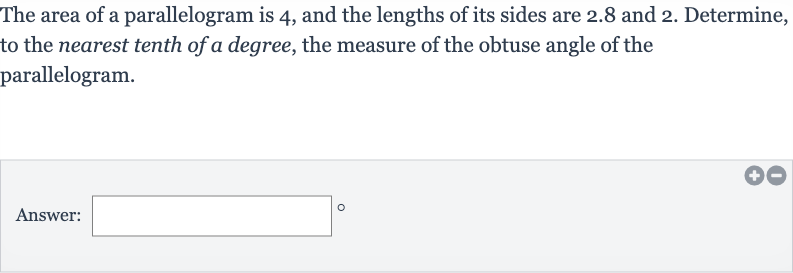Full solution
Q. The area of a parallelogram is , and the lengths of its sides are . and . Determine, to the nearest tenth of a degree, the measure of the obtuse angle of the parallelogram.Answer:
- Area Calculation: To find the measure of the obtuse angle, we need to use the formula for the area of a parallelogram, which is:Area base heightWe know the area () and the length of one side (which we will consider as the base, ). We need to find the height.
- Height Calculation: Let's calculate the height using the area formula: (rounded to four decimal places for accuracy in further calculations)
- Trigonometry Calculation: Now that we have the height, we can use trigonometry to find the measure of the obtuse angle. The height forms a right triangle with the base and the line perpendicular to the base from the opposite vertex. The sine of the acute angle () is the opposite side (height) over the hypotenuse (the given side length of ).
- Acute Angle Calculation: To find the acute angle , we take the inverse sine (arcsin) of : degrees (rounded to the nearest tenth)
- Obtuse Angle Calculation: The obtuse angle is the supplement of the acute angle we just found. Since the sum of angles in a parallelogram is degrees for any two adjacent angles, we can find the obtuse angle by subtracting the acute angle from degrees.Obtuse angle = Obtuse angle = Obtuse angle = degrees
More problems from Convert between customary and metric systems
QuestionGet tutor help
QuestionGet tutor help
QuestionGet tutor help
QuestionGet tutor help
QuestionGet tutor help
QuestionGet tutor help

